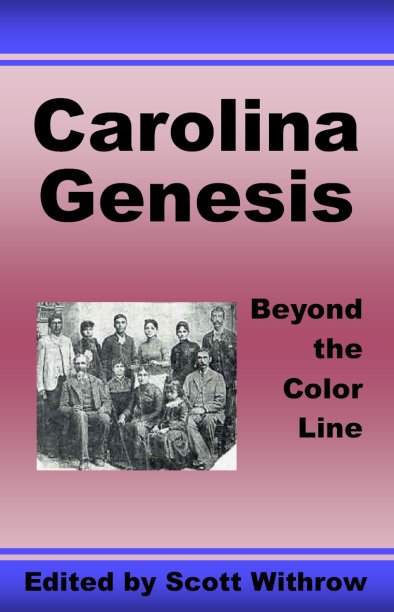Borderlands of “Racial” Identity
Carolina Genesis
by Scott Withrow, editor
Paperback, 258 pages, ISBN 9780939479320, 17.95
Beyond the Color Line
To purchase a copy please contact by email Parrotsgrl@aol.com
Some Americans pretend that a watertight line separates the “races.” But most know that millions of mixed-heritage families crossed from one “race” to another over the past four centuries. Every essay in this collection tells such a tale. Each speaks with a different style and to different interests. But taken together, the seven articles paint a portrait, unsurpassed in the literature, of migrations, challenges, and triumphs over “racial” obstacles.
Stacy Webb tells of families of mixed ancestry who pioneered westward paths from the Carolinas into the colonial wilderness, paths now known as Cumberland Road, Natchez Trace, Three-Chopped Way, and others. They migrated, not in search of wealth or exploration, but to escape the injustice of America’s hardening “racial” barrier.
Govinda Sanyal’s astonishing research uses mtDNA markers to trace a single female lineage that winds its way through prehistoric Yemen, North Africa, Moorish Spain, the Sephardic diaspora, colonial Mexico, and finally escapes the Inquisition by assimilating into a Native American tribe, ending up in South Carolina. He fleshes out the DNA thread with documented genealogy, so we get to know their names, their lives, their struggles.
Cyndie Goins Hoelscher focuses on a specific family that scattered from the Carolinas. One branch fled to Texas, becoming friends with Sam Houston and participating in the founding of that state. Other bands fought in the war of 1812, or migrated to Florida or the Gulf coast. Nowadays, Goins descendants can be found in nearly every state and are of nearly every “race.” To visit this author’s blog, click here.
Scott Withrow (the collection’s editor) concentrates on the saga of one individual of mixed ancestry. Joseph Willis was born into a community of color in South Carolina. He migrated to Louisiana, was accepted as a White man, founded one of the first churches in the area, and became one of the region’s best-loved and most fondly remembered Christian ministers.
S. Pony Hill recounts the historic struggles of South Carolina’s Cheraw tribe, in a reprint of Chapter 5 of his book, Strangers in Their Own Land.
Marvin Jones tells the history of the “Winton Triangle,” a section of North Carolina populated by successful families of mixed ancestry from colonial times until the mid-20th century. They fought for the Union, founded schools, built businesses, and thrived through adversity until the civil rights movement of 1955-65 ended legal segregation.
K. Paul Johnson traces the history of North Carolina’s antebellum Quakers. The once-strong community dissolved as it grew morally opposed to slavery. Those who stayed true to their faith migrated north. Those who remained slaveowners left the church. The worst stress was the Nat Turner event. Its aftermath helped turn the previously permeable color line into the harsh endogamous barrier that exists today. To visit this author’s blog, click here.

You must be logged in to post a comment.